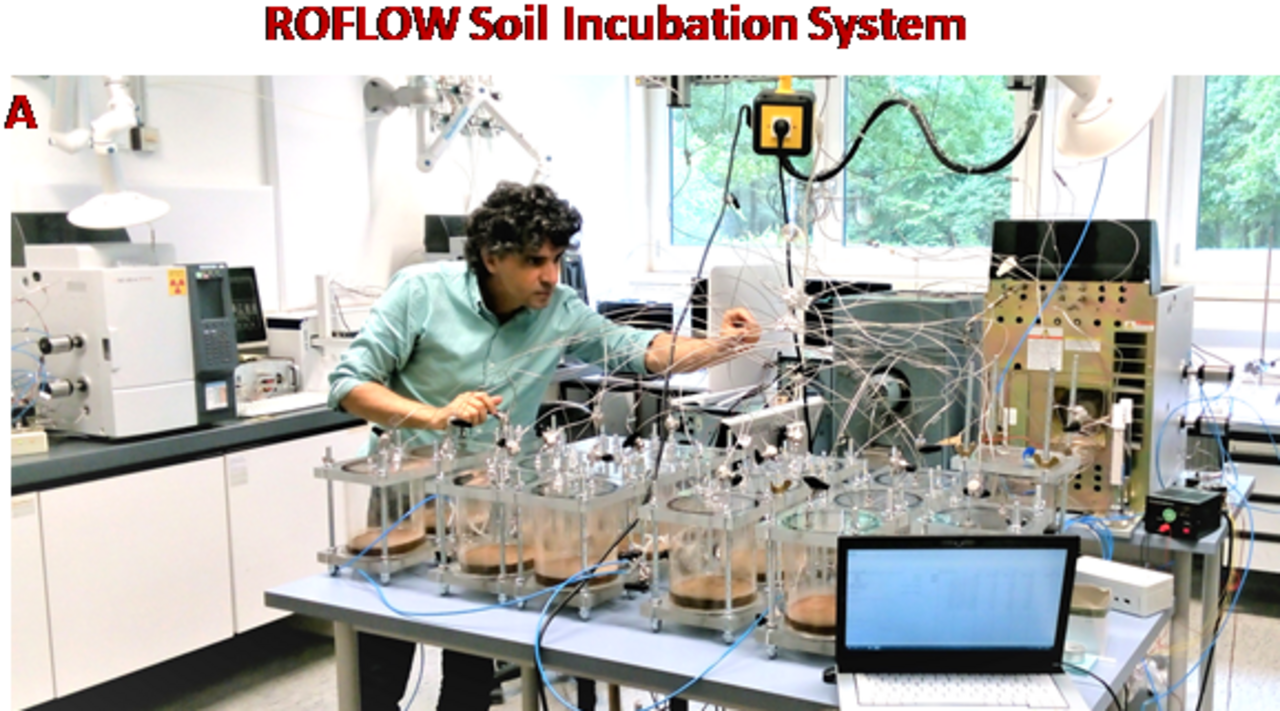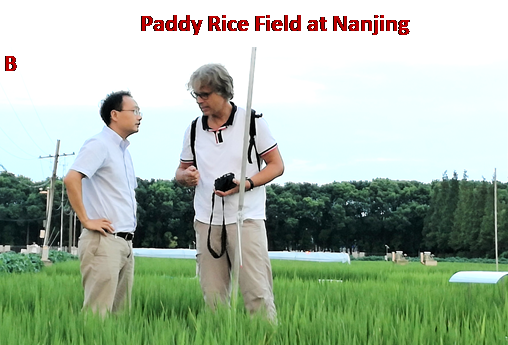Project
Improved quantification of nitrogen flows using new methods

Fluxes and mechanisms of permanent nitrogen removal and N2O production in a heavy nitrogen loaded regions of China (FluxCHINA)
Knowledge on the fate of the massive loading with reactive N from agriculture in the Yangtze River Delta Region in China is poor but needed to develop strategies for effective solutions. In this project we target this gap by developing and applying improved methods to study emissions of dinitrogen and other N gases.
Background and Objective
The massive increase in reactive nitrogen (N) use in agricultural soils has led to a cascade of detrimental environmental consequences including emission of the greenhouse gas nitrous oxide (N2O) via biological processes including denitrification and nitrification. In addition, there is great uncertainty about the fate of applied N as we suspect a large proportion might be lost as dinitrogen (N2) through denitrification. We certainly need to improve current techniques to quantify N2 losses from agricultural soils to better understand the N cycle in various agricultural systems which is needed for optimizing N management.
The Yangtze River Delta Region is one of the most densely populated and economically developed areas in China and being one of the heaviest N loading regions in the world. The research team led by Prof. Xiaoyuan Yan at the Institute of Soil Science at CAS conducted intensive monitoring of N fluxes at watershed scale in the delta region of Yangtze River. By budget calculation it was found that more than half of the N input was permanently removed from terrestrial ecosystems, likely through N2 production, either through denitrification and anaerobic oxidation of ammonium. However, such budget calculation is an indirect method and the results are imprecise, resulting from the cumulated uncertainties of the various N fluxes, each with their respective uncertainty.
In this project, we study soils from three common Chinese agricultural management systems (paddy rice, fruit and vegetable fields) with new robust methods to i) precisely quantify direct N2 and N2O fluxes under different land-use, ii) distinguish the production pathways of N2O for estimating the processes governing N removal, iii) and to understand driving forces of N2O production and reduction processes.
Approach
The research team at the Thünen Institute investigates N cycling in the biosphere and processes governing N2O turnover, with special emphasis in using stable isotope tools to study N transformations in soils and aquifers. A major focus has been the development of methods to measure denitrification at lab and field scales. We enhanced the N2O isotopomer approach to determine N2O producing processes in agricultural soils to use it also for calculating N2O reduction during denitrification.
In this project, we will: a) develop robotized continuous flow soil incubation system to study direct N2 and other N gas fluxes, b) conduct laboratory experiments to validate the N2O isotopomer approach that is used to determine N2O production processes; c) apply the N2O isotopomer approach also to determine the N2O/(N2+N2O ) product ratio; and d) cooperate with CAS work packages to characterize the tempo-spatial variation of denitrification, N2O emission, N2O/(N2O+N2) product ratio and their key controlling factors under field conditions. A fully automated robotized soil incubation system will be established at both, Thünen Institute and Chinese Academy of Sciences (CAS, China), to set up parallel incubation trials for direct N2 measurements and for the calibration of N2O isotopomer approaches.
Our Research Questions
The goals of our work package are::
- Determine direct N2, N2O and NO fluxes from soils of the project sites
- Calibrate and validate the N2O isotopomer approach for the experimental field sites
- Apportion N2O fluxes to the processes of nitrification, fungal denitrification and bacterial denitrification.
- Quantify N2 fluxes and denitrification product ratio at the field scale during phases of expected relevant flux events
- Elucidate control factors of above processes
- Determine potential denitrification rates (the maximum rates of N2O+N2 production under fully anoxic conditions without limitation by nitrate availability) of contrasting soils collected from the Yangtze Delta Region
- Provide data on denitrification gaseous product stoichiometry that improves our process understanding and allows modelling of the important process of N2O reduction as affected by environmental variables.
Thünen-Contact

Funding Body
-
Deutsche Forschungsgemeinschaft (DFG)
(national, öffentlich)
Duration
2.2017 - 12.2020
More Information
Project funding number: WE 1904-12/1
Project status:
finished
Publications
- 0
Senbayram M, Wei Z, Wu D, Shan J, Yan X, Well R (2022) Inhibitory effect of high nitrate on N2O reduction is offset by long moist spells in heavily N loaded arable soils. Biol Fertil Soils 58(1):77-90, DOI:10.1007/s00374-021-01612-x
- 1
Wei Z, Shan J, Well R, Yan X, Senbayram M (2022) Land use conversion and soil moisture affect the magnitude and pattern of soil-borne N2, NO, and N2O emissions. Geoderma 407:115568, DOI:10.1016/j.geoderma.2021.115568
- 2
Wu D, Senbayram M, Moradi G, Mörchen R, Knief C, Klumpp E, Jones DL, Well R, Chen R, Bol R (2021) Microbial potential for denitrification in the hyperarid Atacama Desert soils. Soil Biol Biochem 157:108248, DOI:10.1016/j.soilbio.2021.108248
- 3
Wei Z, Shan J, Chai Y, Well R, Yan X, Senbayram M (2020) Regulation of the product stoichiometry of denitrification in intensively managed soils. Food Energy Secur 9(4):e251, DOI:10.1002/fes3.251
- 4
Senbayram M, Well R, Shan J, Bol R, Burkart S, Jones DL, Wu D (2020) Rhizosphere processes in nitrate-rich barley soil tripled both N2O and N2 losses due to enhanced bacterial and fungal denitrification. Plant Soil 448:509-522, DOI:10.1007/s11104-020-04457-9
- 5
Zhou W, Ma Y, Well R, Wang H, Yan X (2018) Denitrification in shallow groundwater below different arable land systems in a high nitrogen-loading region. JGR Biogeosci 123(3):991-1004, DOI:10.1002/2017JG004199
- 6
Senbayram M, Well R, Bol R, Chadwick DR, Jones DL, Wu D (2018) Interaction of straw amendment and soil NO3- content controls fungal denitrification and denitrification product stoichiometry in a sandy soil. Soil Biol Biochem 126:204-212, DOI:10.1016/j.soilbio.2018.09.005
- 7
Wu D, Wei Z, Well R, Shan J, Yan X, Bol R, Senbayram M (2018) Straw amendment with nitrate-N decreased N2O/(N2O+N2) ratio but increased soil N2O emission: A case study of direct soil-born N2 measurements. Soil Biol Biochem 127:301-304, DOI:10.1016/j.soilbio.2018.10.002

![[Translate to English:] [Translate to English:]](/media/_processed_/6/4/csm_titel_CO2Kampagne8_afeea2273e.png)
![[Translate to English:] [Translate to English:]](/media/_processed_/4/1/csm_titel_93px_CO2Kampagne8_9b0f3354d4.png)

![[Translate to English:] Logo des Bundesministerium für Ernährung und Landwirtschaft](/media/allgemein/logos/BMEL_Logo.svg)